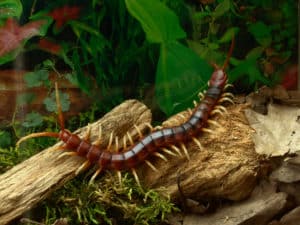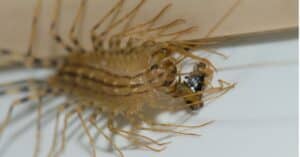Did you know that there are over 3,000 different species of centipedes on the planet today? Scientists even believe that there could be 5,000+ species still left to discover. These sneaky arthropods are known to live in hiding, often being found in cool places such as under rocks, inside logs, and even burrowed beneath the earth. Centipedes live on every continent worldwide except Antarctica. But just how big is the biggest centipede in the world? We’ll tell you in this article and give you our list of the top ten most enormous centipedes on the planet with number one being the biggest centipede on Earth!

You might be surprised to learn that not all centipedes have a hundred legs. Many have as little as 15 pairs of legs and as many as 191 pairs, depending on the type of centipede. They also have the astounding ability to grow new legs as they get older with each molt and can even regenerate them when they are lost.
Centipedes are exclusively carnivorous creatures who feed on small rodents, spiders, insects, and any other creature they can overpower. They are fascinating creatures, so read on for more detail about the largest centipedes.
#10: Giant Desert Centipede (Scolopendra Heros)
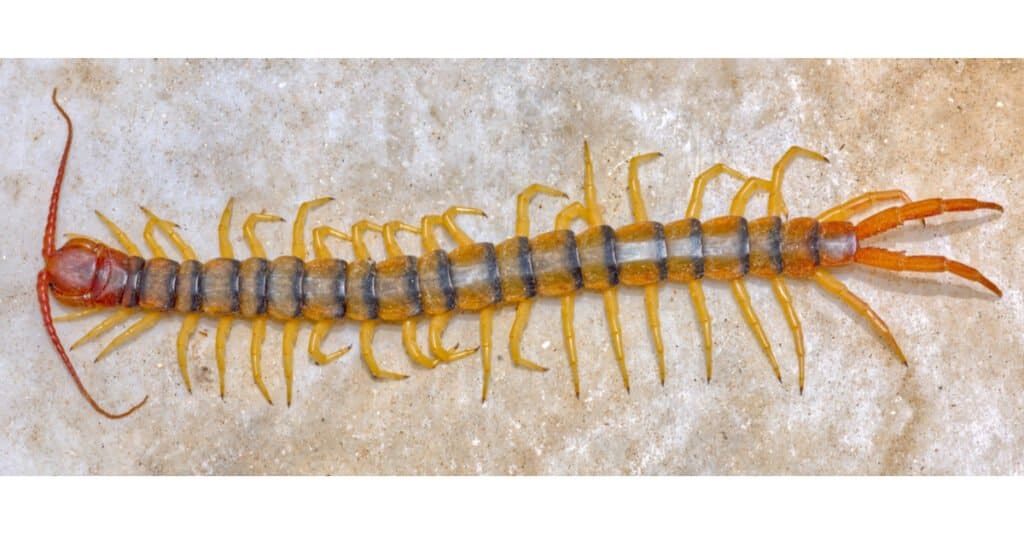
The giant desert centipede which is the largest species in the United States
©Deep Desert Photography/Shutterstock.com
The Scolopendra heros centipede is the largest species in the United States. It measures around 6.5 to 8 inches long and has 21-23 legs. These centipedes primarily live in arid climates such as New Mexico and Arizona, and sometimes in rocky woodland areas.
Scolopendra Heros centipedes are nocturnal creatures who use venom to sedate their prey to make them easier to eat. Their diet includes small rodents, reptiles, and amphibians. They have red heads, black bodies, and yellow legs. The Giant desert centipede’s jaw is one thing that makes them stand out since it is one of the most powerful jaws across all specifies of centipedes.
These centipedes are also known as:
- Texas Centipedes
- Giant Desert Centipedes
#9: Vietnamese Centipede (Scolopendra Subspinipes)
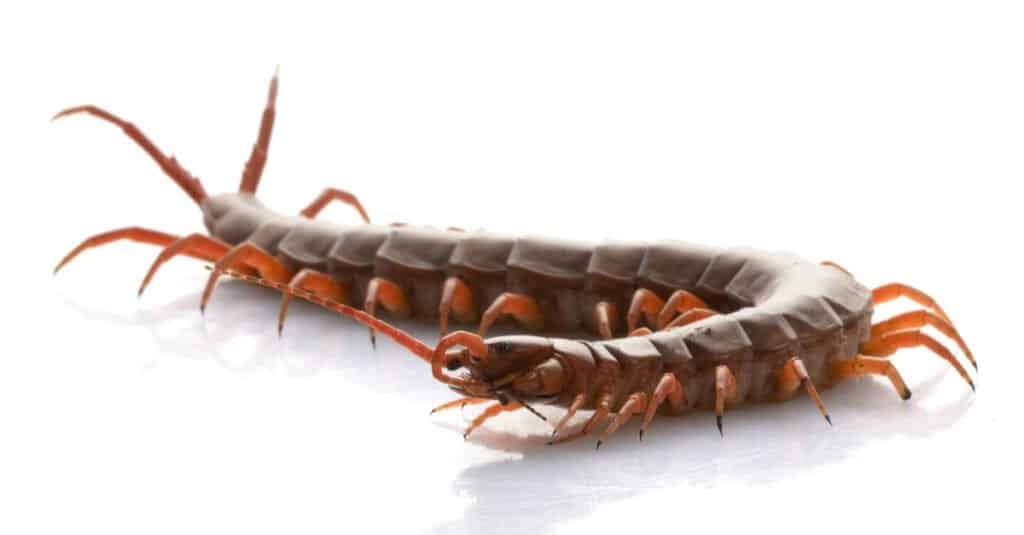
The Vietnamese centipede can be found across a huge geographic area
©fivespots/Shutterstock.com
The Scolopendra subspinipes, also known as the Vietnamese centipede, grows to be around 4” to 10” in length. They come in a variety of different patterns, but most range from dark brown to yellow-brown and have colorful yellow or orange legs.
Despite their name, Scolopendra subspinipes are not exclusive to Vietnam; they are also found in Japan, West Africa, Australia, and even Hawaii. They primarily eat insects, spiders, scorpions, and small rodents.
These centipedes capture their prey, similar to snakes, by wrapping their bodies around their meal, stabbing it with their legs, and using their venom to subdue their prey.
#8: Haitian Giant Centipede (Scolopendra Alternans)

The Haitian Giant Centipede, or Keys Giant Centipede, gets its name from the Florida Keys (shown above).
©Bertl123/Shutterstock.com
The Scolopendra alternans, also known as the Haitian giant centipede or Keys giant centipede, is a large centipede that prefer tropical climates. They range from mahogany brown to light brown and have pale yellow legs.
These centipedes have an eclectic diet that consists of small rodents, amphibians, and even other centipedes. They live that in areas like Cuba, Dominican Republic, the Bahamas, the Florida Keys, and Puerto Rico. They can grow to be over 6 inches long as adults.
#7: Chinese Red-Headed Centipede (Scolopendra Subspines)
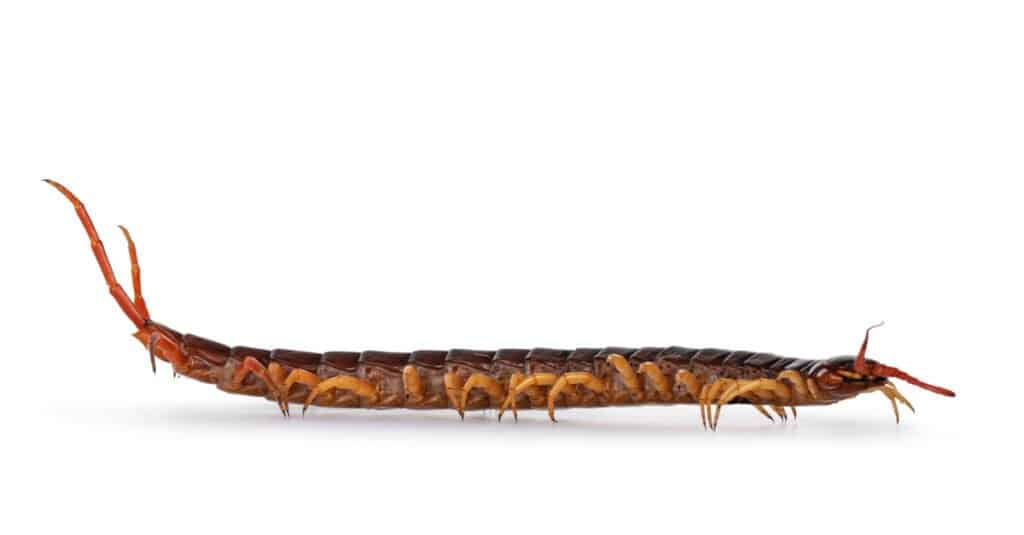
A Chinese red-headed centipede
©Nynke van Holten/Shutterstock.com
Scolopendra subspines, also known as the Chinese red-headed centipede, is one of the world’s biggest centipedes and among the most dangerous. They typically measure around 8 inches long.
These centipedes can be found across Asia and in areas like Australia, Indonesia, and in Central America. They eat mice, small reptiles, and any other animal they can defeat due to their aggressive nature.
These centipedes were used in ancient Chinese medicine for their healing and anti-inflammatory properties. Doctors would place live centipedes on rashes and sores, which was thought to speed the healing process. In Korea, the centipede was roasted, dried, and crushed into a powder to treat chronic pain, boils, and sores.
#6: Sonoran Desert Centipede (Scolopendra Polymorpha)
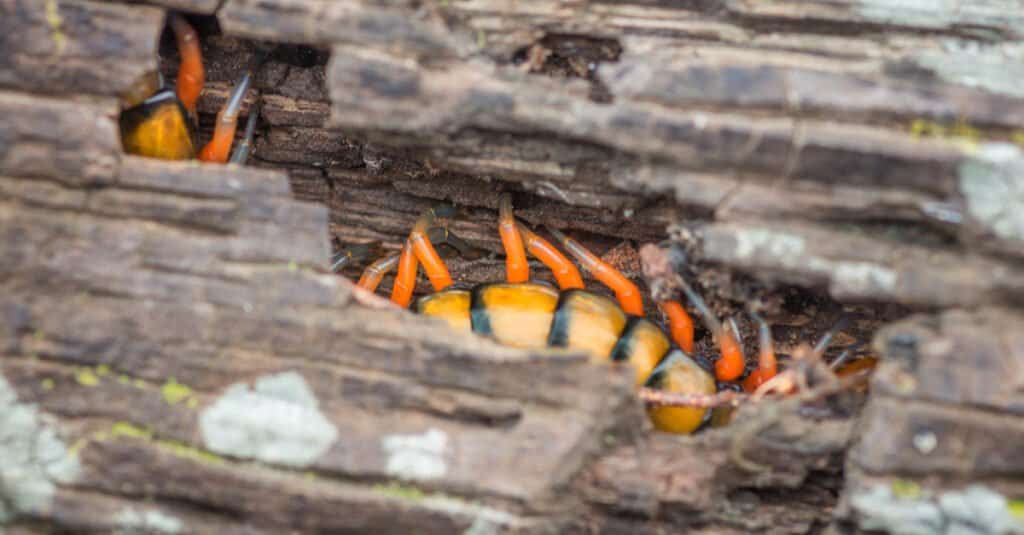
Sonoran desert centipedes can take on a variety of appearances
©muhamad mizan bin ngateni/Shutterstock.com
Scolopendra polymorpha, or the Sonoran Desert centipede, typically reach between four and seven inches in length and have multi-colored bodies. They are sometimes called the tiger centipede or tiger-stripe centipede due to their golden color and deep black lateral stripes that separate each of their sections. Some Sonoran Desert centipedes in southern California are even light blue with darker blue stripes and turquoise legs!
The Sonoran Desert centipede originates in Arizona and prefers to make its home under rocks or in other shady areas during the day. They are most active in the evening during the winter months. For the rest of the year, they stay burrowed to protect themselves against the heat. Their diet is primarily made up of tarantulas, lizards, and other small desert wildlife.
Though there is very little data on the lifespan of the Sonoran Desert Centipede, scientists believe they live an average of five years.
#5: Waterfall Centipede (Scolopendra Cataracta)
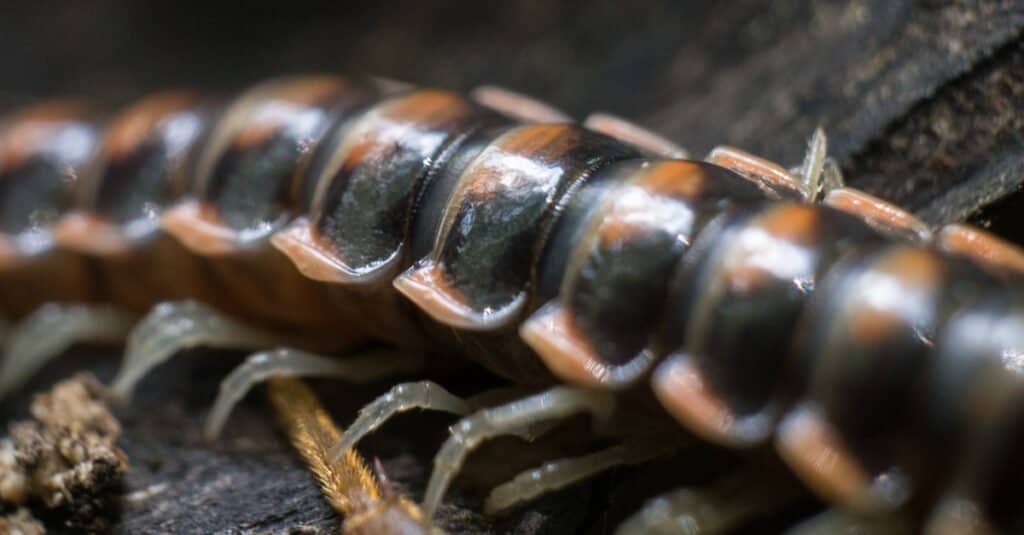
A close up view of the legs of a centipede
©Marshall Barker/Shutterstock.com
Scolopendra cataracta, also known as waterfall Centipedes, grow to be up to 7.9 inches long. They have dark brown or maroon bodies and legs that range from pale yellow to deep red. It is the only known amphibious centipede, which means it can live on land and in the water.
Since these centipedes were only recently discovered in 2001, their entire description is based on just four specimens. They are thought to live only in Southeast Asia. Their bites are venomous and like other centipedes, they are exclusively carnivorous.
Waterfall Centipedes are hydrophobic, which means their outer coating repels water, which allows them to live more effectively in the water. While other centipedes avidly avoid water, Scolopendra Cataracta actively takes shelter in water to avoid predators or other threats.
#4: Indian Tiger Centipede (Scolopendra Hardwickei)
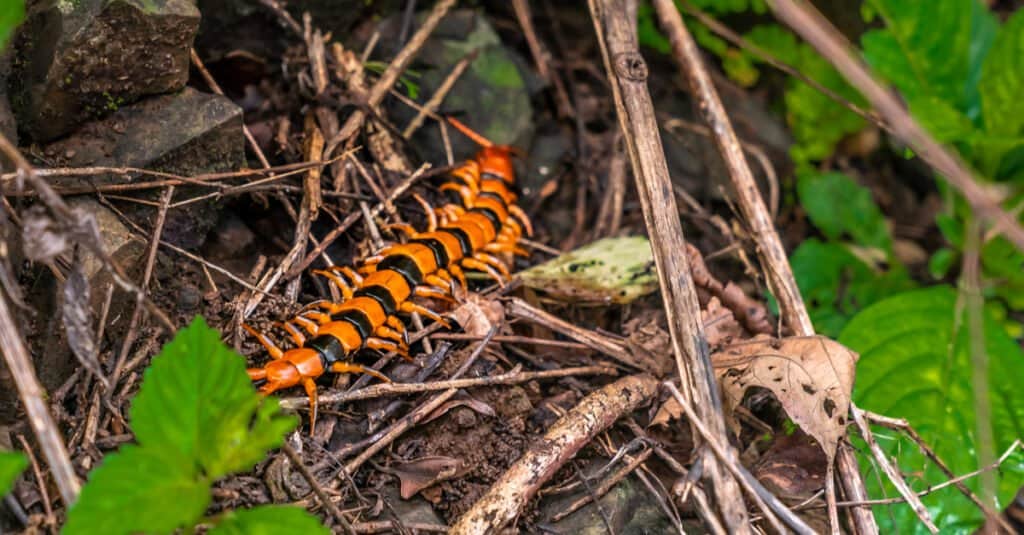
An Indian tiger centipede – you can guess how it gets its name!
©iStock.com/Augustine Fernandes
Scolopendra hardwickei, more commonly known as the Indian Ttger centipede or Hindu tiger centipede, is an arthropod that is known to measure around 6.3 inches long when fully-grown. These centipedes are characterized by their deep orange and black bands and have dark orange heads and antennae.
Indian tiger Ccentipedes are most commonly found across the southern part of India and occasionally in Nikobar and Sumatra. They eat grasshoppers, snails, spiders, and earthworms.
#3: Amazonian Giant Centipede (Scolopendra Viridicornis)
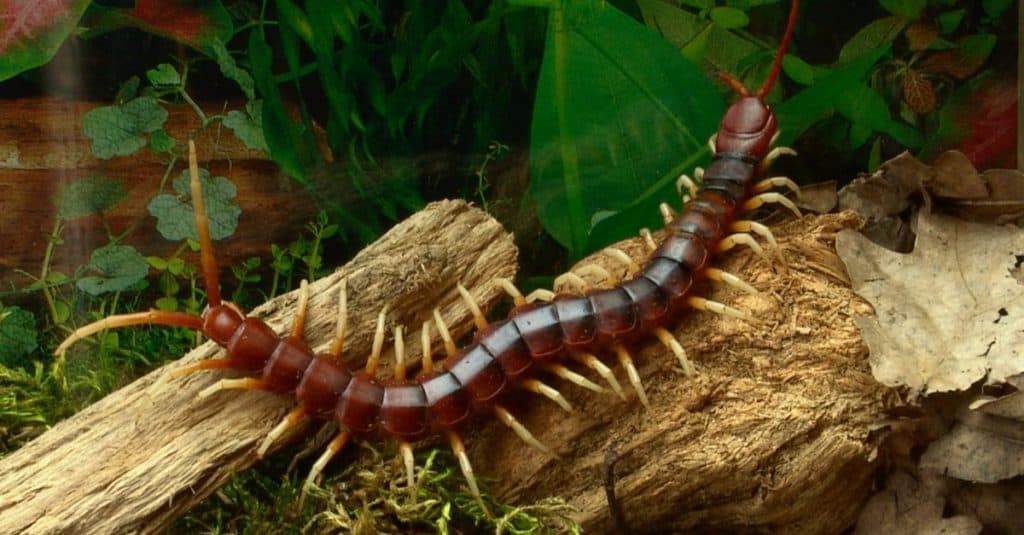
The Amazonian Giant Centipede gets it name from the Amazon Rainforest where it lives.
©skifbook/Shutterstock.com
As its name suggests, the Amazonion giant centipede (Scolopendra viridicornis) is most commonly found in Amazon rainforest, especially in Brazil. They grow to be a little more than 6 inches long.
The Amazonian Giant Centipede’s diet is mostly comprised of small rodents, amphibians, and any other small animal. They have also been known to scavenge when food supplies are low.
Fun Fact: These centipedes’ venom has interesting medicinal properties. Scientists found that one peptid in their venom, called lacrain, kills gram-negative bacteria while leaving human blood cells unharmed, so it can be used as an antibiotic. This venom is also used as an analgesic in traditional Brazilian folk medicine.
#2: Darwin’s Goliath Centipede (Scolopendra Galapagoensis)
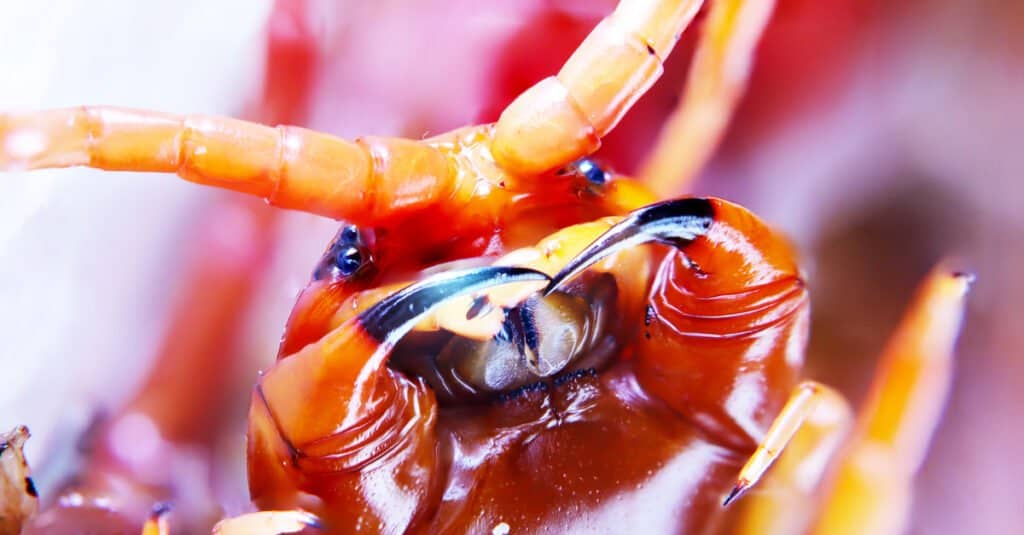
A zoom in on a tropical centipede species’ face
©SAYAN CHAONAMON/Shutterstock.com
Able to grow to up to 11 inches in length, Darwin’s goliath centipede (Scolopendra galapagoensis) is one of the largest centipedes on the planet. Known for their large mandibles and venomous nature, they are also the most dangerous centipede in their habitat on the Galapagos Islands.
Scolopendra galapaoensis are native to the Galapagos Islands and get their name from Charles Darwin, who first discovered the species. They feed on small animals like birds, reptiles, snakes, and bats.
#1: Peruvian Giant Yellow-Leg Centipede (Scolopendra Gigantea)
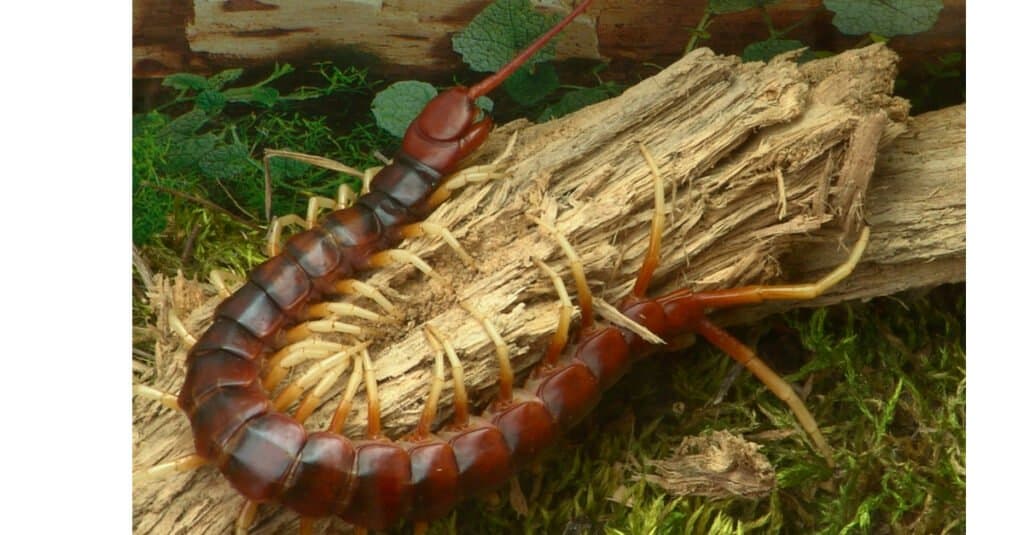
©skifbook/Shutterstock.com
The Peruvian giant yellow-leg centiped (Scolopendra gigantea) is the biggest centipede in the world. Incredibly, the Peruvian giant yellow-leg centipede can grow up to a foot long and eats prey up to fifteen times their size! They range in color, with most centipedes either being dark brown or maroon with yellow legs.
Peruvian giant yellow-leg centipedes mostly live in South America and the Caribbean. They are carnivores, most of their diet consists of a variety of animals such as reptiles, mammals, amphibians, and even other centipedes. They prefer to live and hunt alone, both in the wild and in captivity.
Summary of the 10 Biggest Centipedes in the World!
| Rank | Centipede | Size |
|---|---|---|
| 1 | Peruvian Giant Yellow-Leg Centipede | Up to 1 foot long |
| 2 | Darwin’s Goliath Centipede | Up to 11 inches long |
| 3 | Vietnamese Centipede | Up to 10 inches long |
| 4 | Chinese Red-Headed Centipede | Up to 8 inches long |
| 5 | Giant Desert Centipede | Up to 8 inches long |
| 6 | Waterfall Centipede | Up to 7.9 inches long |
| 7 | Sonoran Desert Centipede | Up to 7 inches long |
| 8 | Indian Tiger Centipede | About 6.3 inches long |
| 9 | Amazonian Giant Centipede | Just over 6 inches long |
| 10 | Haitian Giant Centipede | Over 6 inches long |
The photo featured at the top of this post is © SAYAN CHAONAMON/Shutterstock.com
Thank you for reading! Have some feedback for us? Contact the AZ Animals editorial team.



